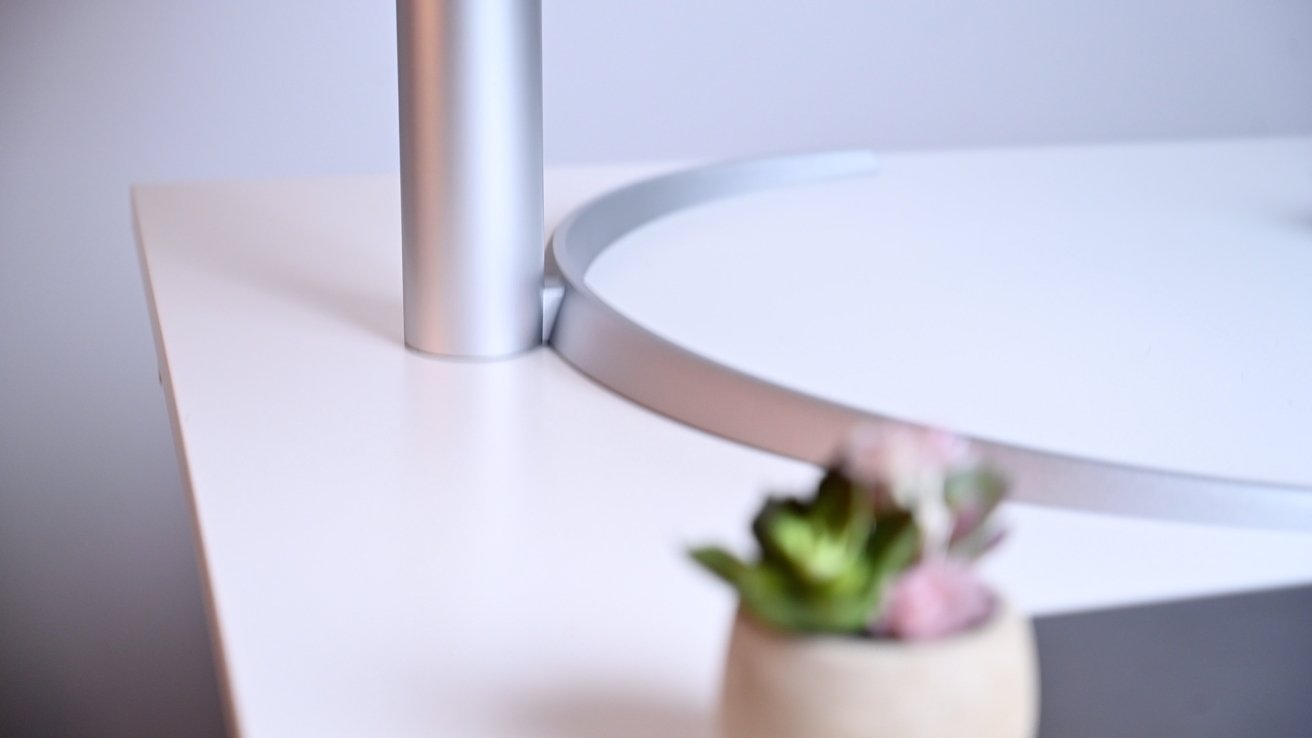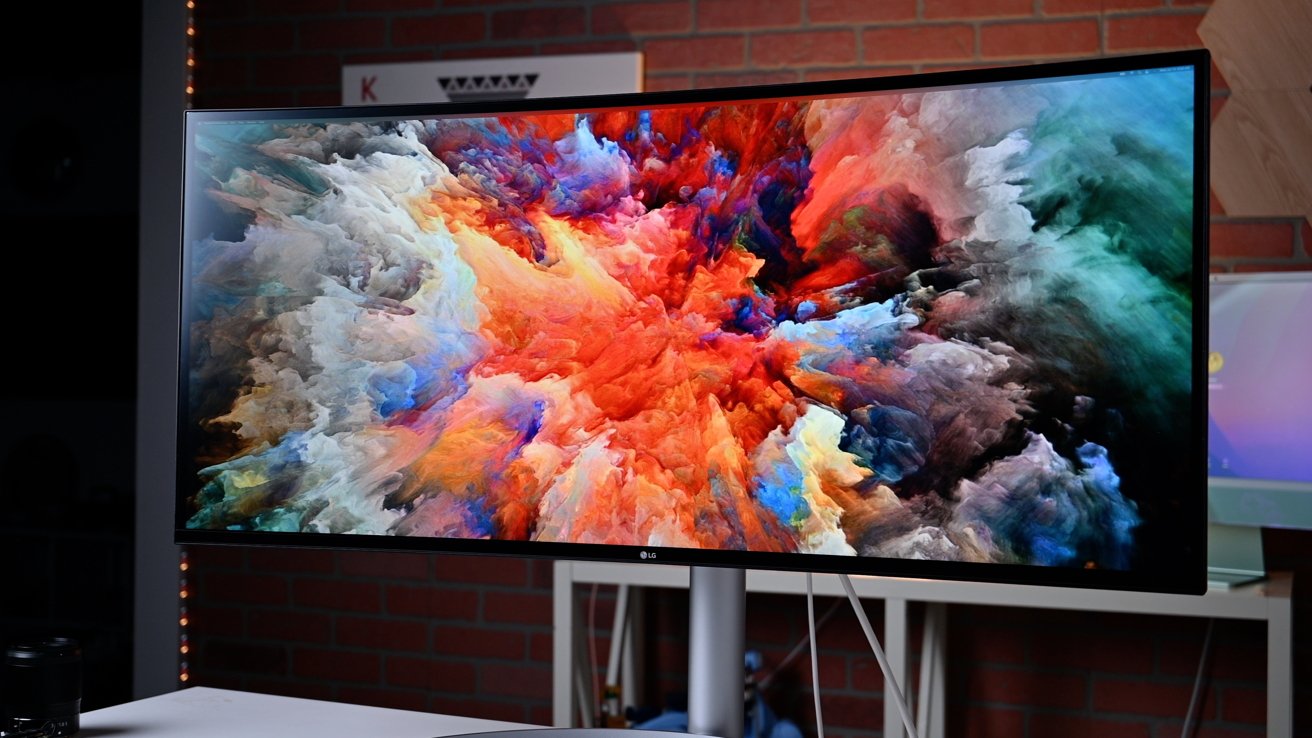The LG UltraWide 40WP95C-W is an exceptional curved Thunderbolt Display that provides valuable screen space to Mac users.
Specifications
This LG monitor is an ultra-wide display with a resolution of 5120 by 2160, commonly referred to as a 5K2K display. With a diagonal measurement of 39.7-inches, that gives us a pixel density of 139.97.
For reference, Apple's 5K Studio Display has a density of 245 pixels-per-inch and the 16-inch MacBook Pro clocks in at 226 PPI. That makes the LG 40WP95C-W notably lower than Apple's panels.
Compared to the MacBook Pro, it is somewhat understandable as you sit a little further from the display and you don't have such a high density to achieve "retina" resolution.
That said, going from the Studio Display to the 40WP95C-W, there is a visible difference in sharpness. While it is a more than acceptable resolution, the Studio Display is very crisp with a very high pixel density for a 32-inch display.
The display has a 5ms response time and a 1000:1 contrast ratio. LG says it supports more than 1.007 billion colors and covers 98 percent of the P3 wide color gamut. Technically, it supports HDR, but the brightness won't yield nearly as impressive results as something like the Pro Display XDR at three times the price.
At its brightest, the 40WP95C-W measures up at 300 nits. This level of brightness is commonplace amongst third-party monitors. We kept the monitor at 70 percent in our usage, but if you're in an overly-bright environment, it might feel a tad dim.
Partially through testing, we enabled the built-in ambient light sensor. This sensor operates just like Apple's and will adjust the display based on the brightness in the room.
A physical joystick on the bottom of the display is used to bring up the on-screen menu. With this, you can adjust the brightness, volume, and other settings.
Ports and connectivity
LG's 40WP95C-W monitor connects primarily via Thunderbolt. It supports Thunderbolt 4, and a nice white Thunderbolt cable is included in the box. Matching the cable to the display's color is a good touch.
On the back of the monitor, you'll find the upstream Thunderbolt port to connect to your Mac and a second downstream Thunderbolt port. With the second port, you can connect a second display.
The Thunderbolt port supports Power Delivery and can charge your Mac up to 96W.
Aside from the Thunderbolt ports, there is a DisplayPort and dual HDMI inputs. The HDMI runs at a lower resolution, supporting a maximum of 3440 by 1440.
What's great about using HDMI, though, is you can run two machines simultaneously. Two computers can be connected simultaneously and run side-by-side in Picture-by-Picture (PbP) mode.
Lastly, there's a 3.5mm audio port on the back too. Granted, if you don't want to use it, there are 10W stereo speakers in the display too.
Hidden behind the right side of the display are two USB 3.1 Type-A ports capable of 5Gbps of data.
Design
We love the design of LG's 40WP95C-W display. It may not be as premium as the Studio Display with an all-metal design, but it's one of the nicest third-party monitors we've tested.
It comes with a highly-adjustable metal stand. There's quite a bit of weight in it as we moved it around the studio. The bottom of the stand is a large, simplistic arc.
This arc adequately supports the display but also gives you plenty of room to work. Instead of taking up a chunk of your desk, it's a very thin line.
The stand snaps into place on the back of the monitor easily and can be done by a single person. A large ball joint connects the stand to the mounting plate, making it adjustable.
You can tilt the display up and down and pivot it left and right. Apple charges a premium for its height-adjustable stand, whereas LG's can adjust its height by default.
The display has a slight curve which is perfect for an expansive display. When we used our last 5K2K display, it was flat. As we looked to the edges of the display, it required more head movement and refocusing on the content.
This curve isn't shallow, but it's not too drastic, either. It allows us to comfortably use the whole display while increasing how immersive the experience of using the display is.
There are relatively small bezels on the display, and it also has minimal movement. As a result, the monitor barely moved when we'd inevitably smack the top of our desk. This is vastly improved from the UltraFine displays that bubbled with typical typing.
We're a little torn on those rear USB ports. We very much hate that they're USB-A ports, as we have only a few type-A devices around these days. They should be type-C in this day and age.
If you have short-term use devices, the placement is excellent. For example, you can connect a thumb drive and remove it without turning the whole thing around. The downside is if you have anything left plugged in, the visible cables are an eyesore.
Living with an ultra-wide display
An ultra-wide display isn't going to be for everyone. Instead, it's a niche product that greatly benefits certain users, especially those who write code or rely on linear editing applications.
Our workflow involves a lot of video editing, which is ideal for a display this wide. The extra real estate allows us to see more of the timeline simultaneously.
We can open up our color boards, effects browser, and angle editor at the same time, with plenty of space to spare.
When not running Final Cut Pro fullscreen, we can run other windows side-by-side. It's great for having a browser window open and a Numbers spreadsheet and Notes. That makes it easy to edit a video while keeping the other information on-screen.
Aside from video editing, audio editors and programmers will also love this display.
Thus far, we've been running the display at its native resolution. There are multiple other scaled modes to choose from, including 2560 by 1080, which will double the size of everything on the screen.
Should you buy the LG 40WP95C-W?
If the aspect ratio of the 40WP95C-W appeals to you, there are very few reasons not to give it a shot. It looks great, has a sturdy and adjustable stand, and connects via Thunderbolt.
Compared to the Studio Display, it isn't quite as tightly integrated into macOS, but it's still an excellent display to boost your productivity.
The speakers aren't fantastic, and the brightness could see a boost, but these are far from dealbreakers.
Pros
- Elegant curved display with strong all-metal adjustable stand
- larger 5K2K resolution
- 96W of power via Thunderbolt with a second downstream Thunderbolt port
- Ambient light sensor to automatically adjust brightness
- HDR support
Cons
- Only average brightness and speakers
- USB-A ports rather than USB-C on the side
Rating: 4 out of 5
Where to buy
The LG UltraWide 40WP95C-W sells for $1,796.99 at B&H, as well as at Adorama and Amazon.
 Andrew O'Hara
Andrew O'Hara












-m.jpg)






 William Gallagher
William Gallagher

 Wesley Hilliard
Wesley Hilliard

 Malcolm Owen
Malcolm Owen
 Marko Zivkovic
Marko Zivkovic

 Chip Loder
Chip Loder




-m.jpg)




10 Comments
I tried this monitor to replace my 38" curved UW but the smaller pixel pitch makes text too small when running at full resolution without scaling. The market is still missing a 40" monitor at 220 ppi which seems to be the right size for normal desktop viewing distances.
Thanks for the on going monitor reviews, buying a curated Apple monitor gets easier with each review, quality really does come at a price.
The studio display’s actual display is hard to beat, true.
So here we are, where LG has produced a larger display, more flexible ports, and an adjustable stand capable of handling a heavier display, at a similar price.